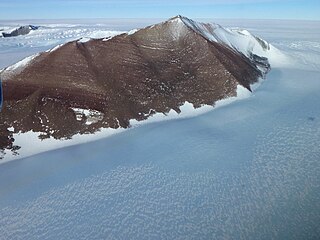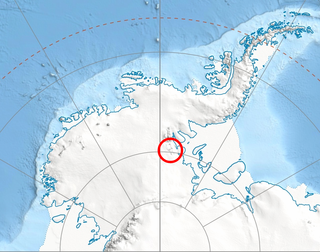Related Research Articles
Mount Markham is a twin-peaked massif surmounting the north end of the Markham Plateau in the Queen Elizabeth Range of Antarctica. The peaks have elevations of 4,350 metres (14,270 ft) and 4,280 metres (14,040 ft).
The Queen Elizabeth Range is a rugged mountain range that parallels the eastern side of Marsh Glacier for nearly 100 nmi from Nimrod Glacier in the north to Law Glacier in the south. Mount Markham, 4,350 metres (14,270 ft) high, is the highest elevation in the range.

The Nimrod Glacier is a major glacier about 85 nautical miles long, flowing from the polar plateau in a northerly direction through the Transantarctic Mountains into the Ross Ice Shelf, Antarctica.
The Geologists Range is a mountain range about 55 km (34 mi) long, standing between the heads of Lucy and Nimrod Glaciers in Antarctica. Seen by the northern party of the New Zealand Geological Survey Antarctic Expedition (NZGSAE) (1961–62) and named to commemorate the work of geologists in Antarctic exploration. The Churchill Mountains are to the north, the Queen Elizabeth Range to the east and the Miller Range to the southeast

The Pensacola Mountains are a large group of mountain ranges and peaks that extend 280 nautical miles in a northeast–southwest direction in the Transantarctic Mountains System, Queen Elizabeth Land region of Antarctica. They comprise the Argentina Range, Forrestal Range, Dufek Massif, Cordiner Peaks, Neptune Range, Patuxent Range, Rambo Nunataks and Pecora Escarpment. These mountain units lie astride the extensive Foundation Ice Stream and Support Force Glacier which drain northward to the Ronne Ice Shelf.

The Byrd Glacier is a major glacier in Antarctica, about 136 km (85 mi) long and 24 km (15 mi) wide. It drains an extensive area of the Antarctic plateau, and flows eastward to discharge into the Ross Ice Shelf.
The Britannia Range is a range of mountains bounded by the Hatherton Glacier and Darwin Glacier on the north and the Byrd Glacier on the south, westward of the Ross Ice Shelf in Antarctica.

The Churchill Mountains is a major range of mountains and associated elevations bordering the western side of the Ross Ice Shelf, between Byrd Glacier and Nimrod Glacier. They are south of the Britannia Range and north of the Geologists Range, Miller Range and Queen Elizabeth Range.

Minnesota Glacier is a broad glacier, about 40 nautical miles long and 5 nautical miles wide, flowing east through the Ellsworth Mountains in Antarctica, separating the Sentinel Range and the Heritage Range. It is nourished by ice from the plateau west of the mountains and by Nimitz Glacier and Splettstoesser Glacier, and merges into the larger Rutford Ice Stream at the eastern margin of the Ellsworth Mountains.
The Cook Mountains is a group of mountains bounded by the Mulock and Darwin glaciers in Antarctica. They are south of the Worcester Range and north of the Darwin Mountains and the Britannia Range.

The Darwin Glacier is a large glacier in Antarctica. It flows from the polar plateau eastward between the Darwin Mountains and the Cook Mountains to the Ross Ice Shelf. The Darwin and its major tributary the Hatherton are often treated as one system, the Darwin–Hatherton.

The David Glacier is a glacier over 60 nautical miles long, flowing east from the polar plateau through the Prince Albert Mountains to the coast of Victoria Land, Antarctica. It enters Ross Sea between Cape Philippi and Cape Reynolds to form the floating Drygalski Ice Tongue. It is the most imposing outlet glacier in Victoria Land. It is fed by two main flows which drain an area larger than 200,000 square kilometres, with an estimated ice discharge rate of 7.8 +/- 0.7 km3/year. The David Glacier was discovered by Ernest Shackleton's "Northern Party," in November 1908, under the leadership of Prof. T.W. Edgeworth David, of Sydney University, for whom the feature was named.

Union Glacier, is a large, heavily crevassed glacier which receives the flow of several tributaries and drains through the middle of the Heritage Range, Ellsworth Mountains, Antarctica. The glacier drains from the plateau at Edson Hills on the west side of the range and flows east between Pioneer Heights and Enterprise Hills. Union Glacier was mapped by U.S. Geological Survey (USGS) from surveys and U.S. Navy (USN) air photos, 1961–66. The name was applied by Advisory Committee on Antarctic Names (US-ACAN) in association with the name Heritage Range.

The Cobham Range is a mountain range in the Churchill Mountains of the Ross Dependency, Antarctica. It extends to the north of the Nimrod Glacier.
The Nash Range is a mainly ice-covered coastal range in the Churchill Mountains of Antarctica.
Turbidite Hill is a low nunatak that lies four nautical miles (7 km) east of Laird Plateau on the north side of Olson Neve in Antarctica. It was mapped by the Holyoake, Cobham and Queen Elizabeth Ranges party of the New Zealand Geological Survey Antarctic Expedition (NZGSAE) (1964–65). It was named after sedimentary features, called turbidites, which were reportedly found in sedimentary rocks of the Beacon Supergroup which forms the summit of this hill.
Mount Hayter is a peak in Antarctica, 2,690 metres (8,830 ft) high, standing 1 nautical mile (2 km) southeast of Laird Plateau on the west side of Olson Neve. It was seen by the New Zealand Geological Survey Antarctic Expedition (1964–65) and named for Adrian Hayter, leader at Scott Base in 1965.
Starshot Glacier is a glacier 50 nautical miles (90 km) long that flows through the Churchill Mountains to enter the Ross Ice Shelf in Antarctica.
Holyoake Range is a mountain range in the Ross Dependency of Antarctice. It is in the southern section of the Churchill Mountains, part of the Transantarctic Mountains System.

The Kent Plateau is an ice-covered plateau in the northern extreme of the Churchill Mountains of Antarctica.
References
![]() This article incorporates public domain material from "Laird Plateau". Geographic Names Information System . United States Geological Survey.
This article incorporates public domain material from "Laird Plateau". Geographic Names Information System . United States Geological Survey.